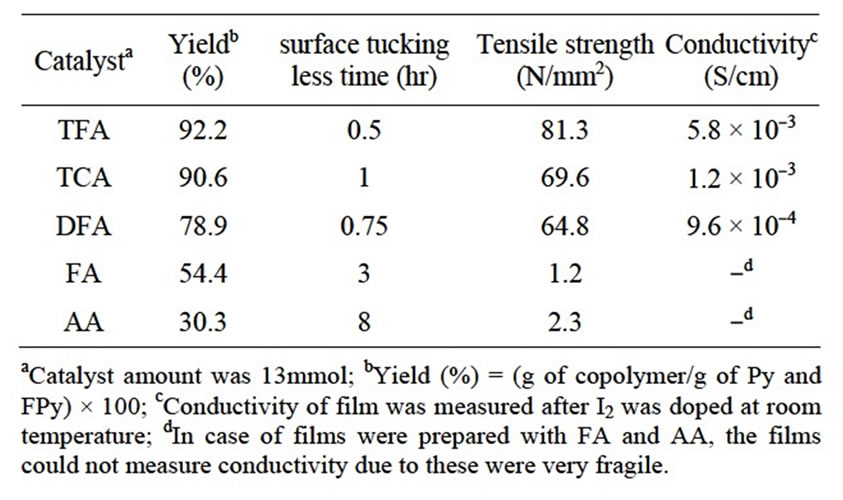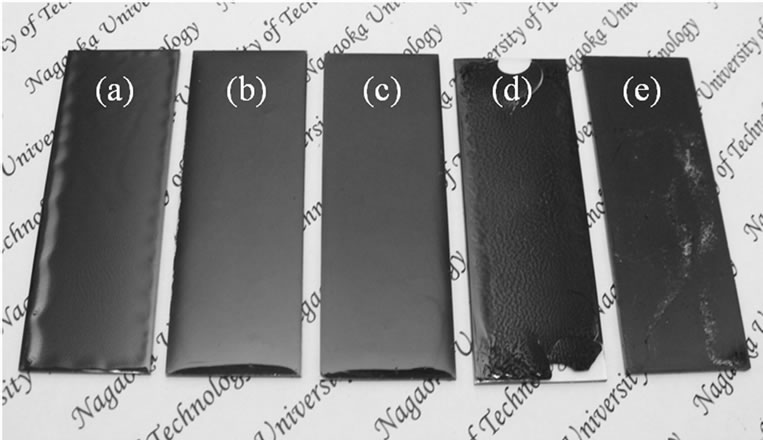Effect of Acidic Catalyst on Properties of Novel Conductive Copolymer Films Made of Pyrrole and Formyl Pyrrole ()
1. Introduction
Electrically conductive polymers with conjugated double bonds have been attracting in much attention of advanced materials. Especially, polypyrrole (PPy) is one of the most promising conductive polymers, because such polymer has higher conductivity and industrial stability in the conductive property relative to state rather than many other conductive polymers [1-8]. It was known that PPy could be easily prepared by chemical and electrochemical polymerization of pyrrole monomer in various organic solvents and in an aqueous media. In their preparation processes, polymerization condition and additives introduced into the reaction mixture influenced the properties of resultant conductive PPy [9-11]. For example, in electrochemical polymerization of PPy [12-14], there was difficulty to fabricate the resultant films because of the limitation of an electrode shape and size. Although chemical polymerization method could prepare a large quantity of PPy, it was known the resultant polymer was limited to powder shape [15-17]. In these cases, generally, acidic catalyst was used in such chemical polymerization of pyrrole to solve this problem. So far, Salmon and coworkers reported chemical polymerization of pyrrole for forming PPy films in the presence of sulfuric acid in ethanol [18]. They mentioned that the films were fragile and unstable in their polymer properties. Consequently, very few investigations were examined for single component PPy films prepared by chemical methods.
On the other hand, little was known about possible of copolymers of pyrrole and another monomer. For example, pyrrole and aniline [19-22], thiophene [23,24], furan [25], and N-substituted pyrrole [26,27] were prepared by chemical or electrochemical polymerization. Although some reports were described advantages of the obtained conductive polymers, their synthetic methods also included numerous steps and reactions facilitated by several instruments.
In contrast, there is possibility for preparation of novel conductive copolymer films by using pyrrole (Py) and 2-formyl pyrrole (FPy). This type of Py-FPy components could expect to construct conjugated structure between Py and Fpy showing methine group (Scheme 1). In a reaction involving Py and a compound containing formyl group for porphyrin, conjugated aromatic cyclic molecules, were normally obtained in the presence of carboxylic acid [28]. In the production of methine group of Py and FPy, it is interesting to form such copolymer backbone for conductive films. Therefore, effect of acid species used as catalyst was examined. Depending on properties of their copolymer films, the acidic catalyst would become important factor on the copolymerization of Py and FPy. In addition, there has been no report on such kind of copolymers made of Py and other monomers. In the present work, the role of acidic catalysts in the copolymerization was studied as a first report in detail by using a series of carboxylic acids in order to compare the properties of the resultant films.

Scheme 1. Chemical structure of Py-FPy copolymer.
2. Experimental
2.1. Material
Pyrrole (Py) monomer was purchased from Tokyo Chemical Industry Co. Ltd. (Tokyo, Japan) and distilled under reduced pressure after dehydration using calcium hydride for 24 hr. Pyrrole-2-carboxaldehyde (2-formyl pyrrole, FPy) was purchased from Tokyo Chemical Industry Co. Ltd. The carboxylic acid catalyst reagents including trifluoroacetic acid (TFA), difluoroacetic acid (DFA), formic acid (FA), acetic acid (AA), were obtained from Nacalai Tesque Inc. (Tokyo, Japan); trichloroacetic acid (TCA) were provided Tokyo Chemical Industry Co. Ltd. The chemical dopant, iodine (I2), was a product of Nacalai Tesque Inc. Water was distilled before use.
2.2. Copolymerization of Py and FPy with Various Carboxylic Acids
Py (200 mg, 3 mmol) and FPy (286 mg, 3 mmol) were dissolved and then stirred in 2 mL of chloroform (CHCl3) in a sample tube (20 mL). Then, the solution containing each carboxylic acid (13 mmol) and CHCl3 (2 mL) was added to the monomer solution at room temperature, when the polymerization was started. Here, different carboxylic acid such as TFA, TCA, DFA, FA and AA were used for each copolymerization. For example, when the TFA was added to the monomer solution, the solvent color changed immediately from transparent brown to yellowish red. Then, the mixed solution was spin-coated onto the petri dish at 20 rpm using a spin coater (Opticoat MS-A100; Mikasa Co. Ltd., Japan). Each copolymerization was carried out for about 0.5 - 8 hrs at room temperature, and then a film was formed in the petri dish. It was confirmed that the black color film was insoluble in several solvents. After the copolymerization of Py and FPy, the resultant films were ground down and washed well with water and acetone. The precipitates were stirred with 3 wt% of NaOH in aqueous solution for 0.5 hr in order to remove the acid catalyst. Then, the solution was stirred with 2N HCl aqueous solution at 0.5 hr to convert them to acidity. The obtained black precipitates were dried in a vacuum oven at 60˚C for 12 hr. These samples were used for Fourier transfer infrared (FT-IR) spectrometry (Prestige-21; Shimadzu Corp., Japan). For the measurement of electrical conductivity, iodine was doped on the film. Each film was washed with water and acetone and then put in a closed vessel containing a small amount of iodine for chemical doping. Then, the electrical conductivity of the doped film was determined.
2.3. Measurements
Characteristics of the resultant Py-FPy copolymers including electrical conductivity, tensile strength, FT-IR and UV-Visible spectrophotometry were measured. The value of electrical conductivity of each film was obtained using a typical four-point method (Roresta-GP MCPT610; Mitsubishi Chemical Analytec Co. Ltd., Japan) at room temperature. Before measurement of the conductivity, the film was placed in I2 atmosphere for about 24 hr. Then the values of electrical conductivity of the doped film were determined with the four-point probe as attached to the surface of the film at five points. The tensile strength of the films was measured using a load cell (LTS-500N; Minebea Co. Ltd., Japan) for the sample specimen (2.5 cm × 7.5 cm). FT-IR spectra of the resultant films were also determined using a FT-IR spectrometer in the transmittance mode. Transmission spectra were obtained using KBr method. The spectral resolution was 4 cm–1 for each spectrum. The UV-Visible spectra of thin films having about 1 - 10 μm thickness on the quartz glass were measured using a UV-VIS-NIR spectrophotometer (V-570; Jasco Corp., Japan) in absorption mode.
3. Results and Discussion
3.1. Properties of Py-Fpy Copolymer Films Prepared in the Presence of Different Catalyst
In order to examine effect of catalyst on Py-FPy copolymer films, five species of carboxylic acids were used for the copolymerization. Table 1 shows several carboxylic acids used as catalyst for preparation of resultant copolymer films. It was obviously observed that the copolymerization time was varied when the chemical structure of the catalyst was changed. When the AA was used, surface tucking less time (STLT) observed on the film surface was about 8 hr. However, as the TFA catalyst was used, the value of STLT was about 0.5 hr, indicating the polymerization was quickly occurred. The resultant value of the yield also indicated that both TCA and TFA showed high yield of the copolymerization. In the cases of AA and FA, the yields became low relative to those of TFA, TCA and DFA. Furthermore, it was noted that the films obtained showed somewhat different view. As presented in Figure 1 for typical pictures of the resultant films copolymerized with TFA (a), TCA (b) and DFA (c), the view was like metallic black and different color grow. In contrast it was easily seen for FA (d) and AA (e) to lead fragile black films. As shown in Table 1,

Table 1. Polymerization yield, surface tucking less time, tensile strength and conductivity of Py-FPy copolymer synthesized using various carboxylic catalysts.

Figure 1. Pictures of Py-FPy copolymer films prepared with TFA (a), TCA (b), DFA (c), FA (d) and AA (e).
the latter had very low tensile strength in the range of 1.2 - 2.3 N/mm2. However, the films produced with TFA and TCA showed good results in copolymer yield and film strength.
Figure 2 show FT-IR spectra of copolymer films prepared by each carboxylic acid before (a) and after (b) removal of the catalysts from the film. In spectra (a), each spectra had C=O stretching band at about 1680- 1640 cm–1 region. However, after washing the catalyst, the spectra (b) showed disappearance of the strong C=O stretching near 1680 - 1640 cm–1. When comparison was made in the maximum peak of TFA catalyst without and with the film, the values of wavenumber for the C=O band were 1780 and 1670 cm–1, respectively. Furthermore, the characteristic OH band of TFA could not appear in 3300 - 3400 cm–1 as observed in spectra (a). These results meant that the C=O group was interacted with the Py-FPy film and the acidic proton for protonating in the Py nitrogen of the film. In Figure 2(b), the FT-IR spectra of copolymer films for FA and AA showed still presence of the stretching band assigned with C=O, although washing operation was carried out. This meant that the brittle films were oxidized. It was also observed that appearance of the N-H stretching vibrations of two types (3380 and 3260 cm–1) and the C=C double bond stretching of the pyrrole ring of two types (1626 and 1538